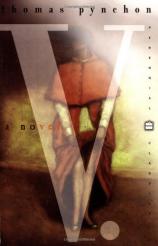Reading Group Guide
Discussion Questions
V

1. To what extent can V. be read as "an analysis" of the decadence of the 1950s and, by extension, of the decadence of all of twentieth-century western culture?
2. In what ways is Benny Profane a "schlemihl" and a passive victim of circumstances? What are the causes and consequences of his repeated, frequently self-professed victimization? As a "human yo-yo," how is he the plaything of his culture and of history?
3. What are the nature and purpose of Herbert Stencil's quest? What does Pynchon mean when he writes that "Stencil was in time to be the century's child"? How does Stencil's search for V. reveal the decadence of European colonialism and of twentieth-century western culture?
4. Who are the various women who bear the initial "V"? What do these women represent? In addition to these women, what other persons, objects, places, and concepts are associated with the letter? How does the letter "V," as the novel's title and central symbol, effectively focus all of the primary motifs in the novel?
5. How does Pynchon illustrate the concept of entropy--the deterioration of all systems to a state of absolute inertness in which all creative energies have been dispersed? What characters and situations are most pointedlyassociated with entropy? What "rescues" from decay and deterioration dovarious characters put forward, and with what results?
6. What are the layouts and goals of the novel's various labyrinths ormazes, of either space or time? What do Profane, Stencil, and othercharacters discover about themselves and about history as they navigatetheir labyrinths?
7. What do Chiclitz, Schoenmaker, Winsome, and Eigenvalue represent?How are they related to the British Foreign Office men, Nazi officers, andother professionals who figure in Stencil's quest?
8. In what ways--and to what degree--do Profane, Stencil, and others attempt to create order out of disorder? Is any one character's approach in this regard more successful than those of the others?
9. Herbert Stencil's father says, "Suppose, sometime between 1859 and 1919, the world contracted a disease which no one ever took the trouble to diagnose because the symptoms were too subtle--blending in with the events of history, no different one by one but altogether--fatal." How would you describe that disease? How may V. be read as Pynchon's diagnosis of it?
10. Rachel thinks of the people in Dr. Schoenmaker's waiting room as only one group of "a transient population of the imperfect, the dissatisfied." In what ways do you think Rachel's perception describes all the characters in the novel?
V
- Publication Date: March 24, 1999
- Paperback: 560 pages
- Publisher: Harper Perennial Modern Classics
- ISBN-10: 0060930217
- ISBN-13: 9780060930219







